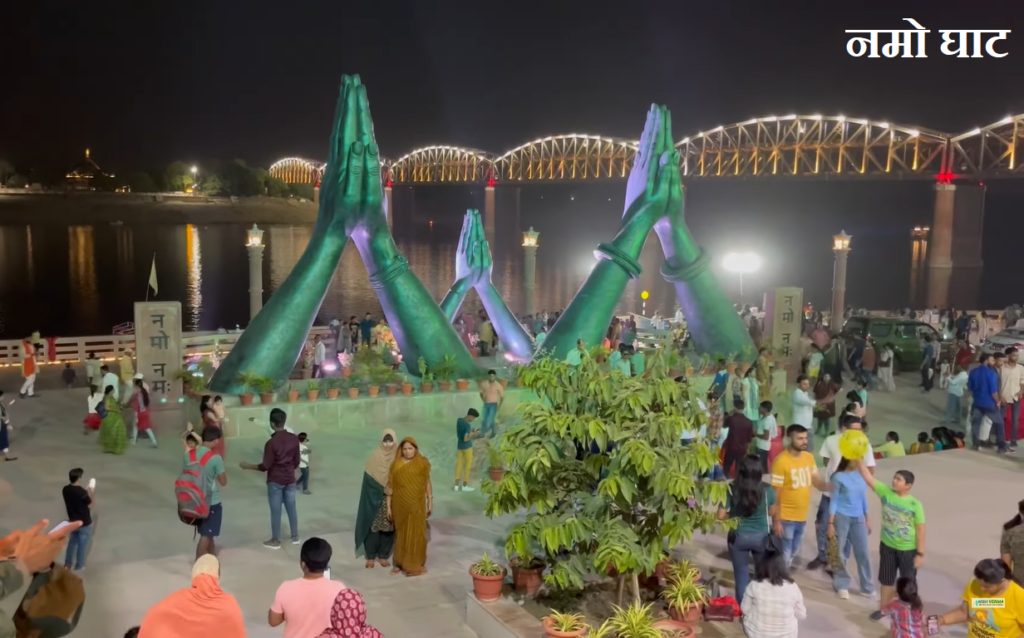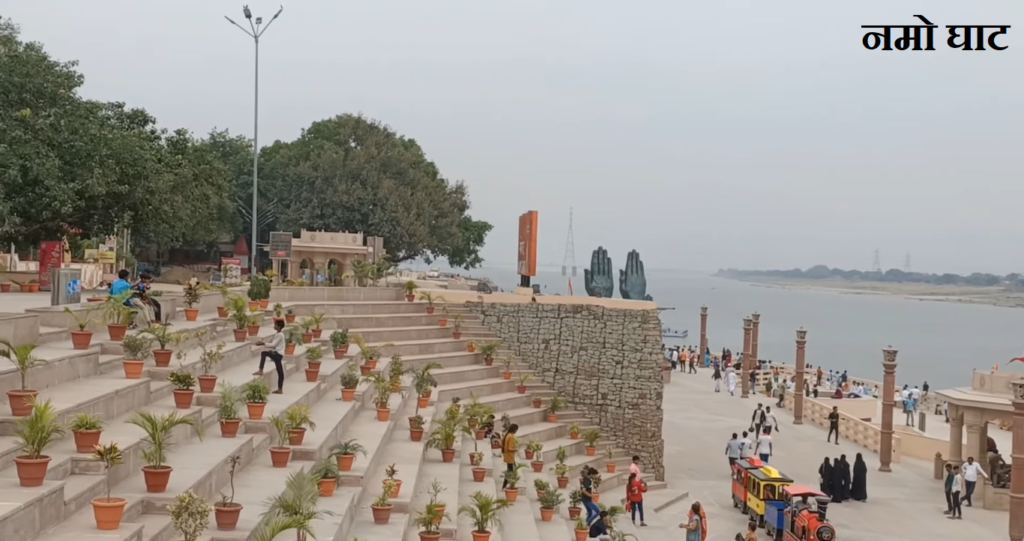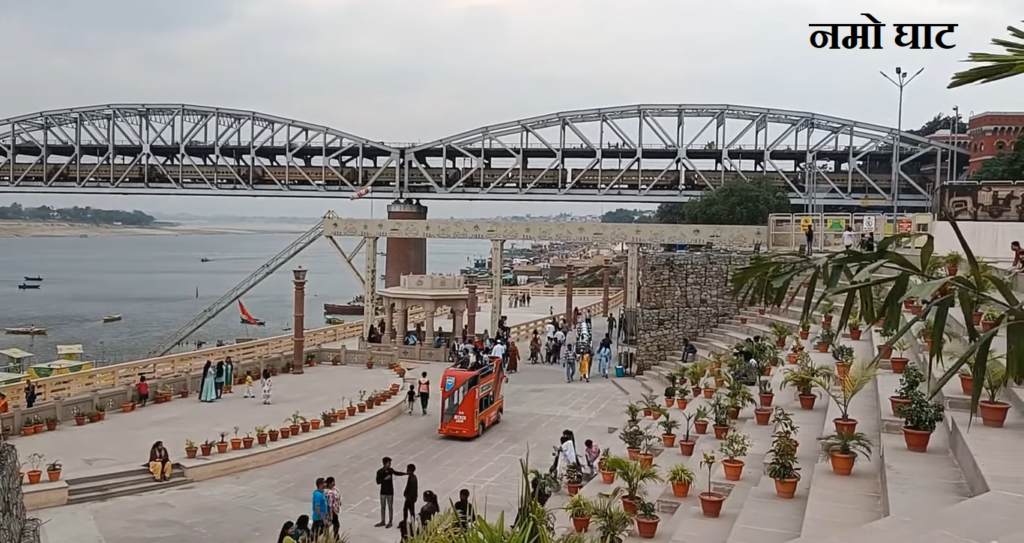Exploring India’s Cultural and Spiritual Heartland: Varanasi
Varanasi, the city full of dazzling charm doesn’t need any introduction. This place is the best if you value calmness and inner peace. Everyone has heard about the heaven but if you want to experience it on the Earth then you must visit Varanasi. You can take part in a variety of religious rituals and feel the presence of gods here. Tourists come there from all over the world for various such reasons. Not only to live in Varanasi, Hindus believe that if they die in this holy city, they would be released from the endless cycle of reincarnation. Apart from religious significance, Varanasi has much more to explore. One of the major tourist attractions in this holy city is the newly reconstructed “Namo Ghat”. Let us explore this beautiful place in detail.
The Mystical Beauty of Varanasi: Namo Ghat

There are 84 ghats in this holy city. Thousands of people flock to the ghats of the Ganges every day in Varanasi. The ‘Khidkiya ghat,’ is reconstructed and came to be known as ‘Namo Ghat’. The Namo Ghat in Varanasi is now the 85th ghat in the city.
One of the most striking elements of this ghat is a magnificent hand folded sculpture. Because of three massive sculptures in the shape of hands folded in ‘namaste,’ it has become a popular tourist attraction. Namo is an expression of our culture in which we welcome visitors by joining our palms and saying “Namaste.” The sculptures of folded hands became the new identity of the ghat. They appear to welcome our visitors to the land of Kashi.
Namo Ghat is Kashi’s first Ghat to be accessible by water, land, and air. The city has what seems to be the new Kashi look, which is something that attracts many visitors. Its minimal interior design and traditional Kashi wall paintings throw off an air of both modernity and heritage. Visitors to Varanasi will see a visual representation of our culture and respect for them here.
A Journey into Varanasi’s Sacred Namo Ghat
Its name, NaMo, which also means Namaste mudra, is said to be taken from the name of our beloved Prime Minister NArendra MOdi.

This ghat has had many improvements made to it, including a plaza with souvenir and local artwork shops, CNG filling stations for vehicles on the ground level and Boats on the river bank, a jetty for boarding and releasing boats, and instructions and lighting. Here, students would have space for strolling, exercising, and yoga, as well as access to water adventure activities. Additionally, there will be an open theater, a library, a food court featuring Banarasi cuisine, and a versatile platform that may be utilized as a helipad or to organize other events. For the benefit of the elderly and those with disabilities, a ramp has been constructed all the way to the river. Divyangjan can walk or roll his wheelchair onto this ghat from the road, putting them right next to Maa Ganga. It is unique in the way that no other ghats give equal attention to people with disabilities.
To clean up the Ganga, a floating CNG station has been constructed by GAIL India near the ghat for CNG boats. Additionally, it would be possible to take a ship to see other surrounding cities. A half kilometer long, Namo Ghat features advertisements for Make in India and Vocal for Local. There is a cafe, platforms, and murals on the walls that display Kashi’s cultural past. Tickets for “Sugam Darshan” at Kashi Vishwanath Dham would also be available here, and pilgrims would have the option of traveling by boat from the jetty to Kashi Vishwanath Dham. This location now features parking spots, a playground, and an area for clicking pictures.
The Making of Namo Ghat

The restoration of the Khidkiya ghat was officially began in 2019 with the laying of a foundation stone by Prime Minister Narendra Modi. The ghat was renamed “Namaste” after sculptures of folded hands were built. This ghat, which covers an area of roughly 21,000 square meters, racked up a price tag of Rs. 34 crores.
D Vasudevan, chief general manager of Varanasi Smart City Limited, said that once construction on phases II and III is finished, Namo Ghat will become the longest ghat along the Ganga in Varanasi, spanning 1.71 km from Bhaisasur Ghat (Rajghat) to Aadi Keshav Ghat at the confluence of the Ganga and the Varuna.
Prime Minister Narendra Modi was scheduled to open the Namo Ghat in July 2022, once phase-I construction was finished, and the statues of three ‘namaste’ (pair of joined hands) were placed there as a welcoming gesture. However, plans were altered, and it was determined that the official opening would take place once the final phase of construction was finished. The Namo Ghat project’s second and last phase will be finished by June, and it will be formally inaugurated at that time.
Best Time to Encounter the Stunning Scenery of Namo Ghat
The afternoons and evenings in Varanasi are the most popular times to visit. Namo Ghat is at its most beautiful in the early or late hours of the day. Mornings and evenings are the best times to visit Namo Ghat because that’s when the region is at its busiest and the light is at its greatest for photography. If you want to feel the ghat’s revitalizing energy, you should come early in the day. There’s plenty of room to park, and the entrance is well-marked and secured. Witnessing the beauty of holy river Ganga in the evening will be much delight to the eyes. However, the sightseeing on boat will be like the icing on the cake.
If looking about season, Namo Ghat is at its most beautiful during the winter months of November through February. In Varanasi, the temperatures range from about 5 degrees Celsius to about 25 degrees Celsius throughout this season, making it perfect for outdoor activities and tourism.
How to Reach Namo Ghat
Namo Ghat is situated near Rajghat Varanasi, Uttar Pradesh. It is easily accessible through different modes of transportation. People in Varanasi or from outside cities can easily manage to reach there.
By Roadways: Varanasi has excellent road connections to other regional hubs. Namo Ghat is easily accessible from everywhere in Varanasi via cab, auto, e-rickshaw, or cycle-rickshaw. The Varanasi Cantt bus station is located around 6 kilometers from Namo Ghat.
By Railways: The Varanasi Junction railway station is the main city station that connects the city to other important Indian cities. The distance from the Varanasi station to the Namo Ghat is about 6 to 7 kilometers. Outside the station, you can find auto rickshaws and taxis. Passengers can also use a private cab service to reach the destination spot.
By Airways: Lal Bahadur Shastri International Airport is the closest airport to Varanasi. To get to Namo Ghat from the airport, you can either rent a cab or take a pre-paid taxi. By road, the distance between Varanasi Airport and Namo Ghat is 25 km via NH31. It takes approximately 55 minutes to reach Namo Ghat.
If you are a travel enthusiastic, Varanasi should be in your travel list. The perfect blend of modernity and heritage will give you a unique and unforgettable experience. Happy journey!!
Places to Explore near Namo Ghat
Namo Ghat is a holy site with breathtaking scenery. You can find inner calm and enlightenment there. There are a number of interesting ancient temples in the area around Namo Ghat. Several well-known temples, including the Kashi Vishwanath Temple, the Sankat Mochan Temple, and the Durga Temple, may be found in close proximity to Namo Ghat. Nearby Namo Ghat, you’ll find lively marketplaces stocked with authentic regional goods and specialties. Some of the famous places where you can visit during your journey of Namo Ghat are listed below:
Kashi Vishwanath Temple: One of the most well-known temples in the sacred city of Varanasi is Shri Vishwanath Mandir, also known as New Vishwanath Temple. Dedicated to the god Shiva, the temple may be found on the campus of Benaras Hindu University. Shri Vishwanath Mandir is home to a number of temples that are devoted to various gods and goddesses, such as Nataraj, Saraswati, Mata Parvati, Hanuman, Ganesha, Panchmukhi Mahadev, and Nandi.
Sankat Mochan Temple: The Hanuman Temple in Sankat Mochan is one of the holiest sites in Hinduism. The temple of Sankat Mochan is said to be built on the same spot where Tulsidas saw Lord Hanuman. Due to the abundance of monkeys on the campus, this place is also known as the Monkey temple. The distance between Namo Ghat and Sankat Mochan Temple is approximately 8 km.
Durga Temple: Dedicated to the Hindu goddess Maa Durga, this temple holds significant religious significance. Rani Bhabani of Natore supervised the building of Durga Mandir in the 18th century. The kund (pond) next to the temple used to be connected to the Ganges River. The distance between Namo Ghat and Durga Temple is approximately 7 to 8 km.
BHU Campus: Located in the sacred city of Varanasi is the world-famous Banaras Hindu University. It borders the Ganges to the south and lies on the outside of Varanasi. The BHU campus in Varanasi encompasses over 2.7 square kilometers. Banaras University’s prestige as an educational institution extends well beyond India. The distance between Namo Ghat and BHU Campus is approximately 10 to 11 km.
Assi Ghat: Assi Ghat is a frequent destination for both visitors and locals in Varanasi. Several of the oldest Hindu texts, including the Matsya Purana, Agni Purana, Kurma Purana, Padma Purana, and the Kashi khanda, make reference to Assi Ghat. The distance between Namo Ghat and Assi Ghat is approximately 7 to 8 km.
Back lashing the Entry Fee
Many people on social media have voiced their disapproval of the Varanasi’s decision to charge a fee of 10 rupees per person to enter a newly renovated Ghat. While others have pointed out the need for regulating the massive crowds that come into the area every day. Officials explained that the entry fee was established to prevent undesirable individuals and fund the maintenance of the Ghat.
One user in social media tweeted that the funds were required for maintenance and that the price was reasonable. Former MLA and Congress politician Ajay Rai had previously criticized the government for the entry fee, stating that those living in the prime minister’s constituency would now have to pay tax to freely wander the ghats and parks. After the government “ruined” the country’s economy, he said, they began “commercialising faith.” Manoj Rai, spokesman for the Samajwadi Party, said earlier in the day, “Now without paying, people will not be able to reach Maa Ganga for religious works.” In the morning, Congress leader and Varanasi resident Gaurav Kapoor, national convener of the party’s research department, tweeted a photo of the admittance ticket and called it a foolish action. Access to a Varanasi Ghat now requires a ticket for the first time in the city’s history. This is the incorrect choice, and it needs to be reversed.
There was a Smart City Varanasi emblem on the ticket, and it said that the holder could stay for four hours. The ticketing system has been placed on hold for the time being after receiving tremendous pushback from the public and criticism from opposing parties. However, it was learned from reliable sources that the Smart City Company was still imposing an admission charge.
